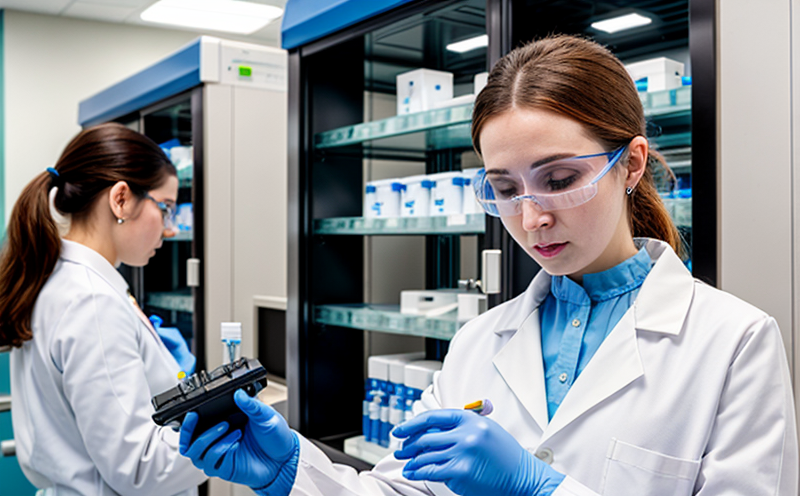Pharmacokinetic Bioanalytical Assay Testing
Pharmacokinetic bioanalytical assay testing is a critical component of pharmaceutical development that ensures new drug candidates are safe and effective. This service involves the quantitative determination of drug concentrations in biological specimens, such as blood or plasma, following administration to humans or animals. The primary goal is to understand how drugs behave within the body over time, including absorption, distribution, metabolism, and excretion.
The process begins with the selection of appropriate bioanalytical methods that adhere to rigorous international standards like ISO 15195:2016 and ASTM E2348-17. These methods ensure accurate and reproducible results, which are essential for regulatory submissions. Specimen collection is meticulously managed, ensuring minimal interference with the drug's behavior in vivo.
The instrumentation used in pharmacokinetic bioanalytical assay testing includes advanced analytical platforms such as liquid chromatography coupled with tandem mass spectrometry (LC-MS/MS). This technology allows for precise quantification of drugs and metabolites even at trace levels. The data generated is then processed using specialized software to produce comprehensive reports that include pharmacokinetic parameters like Cmax, Tmax, AUC, and half-life.
This service plays a crucial role in drug development by providing critical information for dose selection, formulation optimization, and potential toxicological assessments. Regulatory agencies such as the FDA and EMA mandate these tests to ensure compliance with stringent safety and efficacy requirements.
| Drug Metabolism Pathways | Common Analytes |
|---|---|
| Phase I: Oxidation, reduction, and hydrolysis | Metabolites of the parent compound |
| Phase II: Conjugation reactions (glucuronidation, sulfation) | Conjugated metabolites |
| Phase III: Transporters and efflux pumps | Drug-drug interactions |
The testing process involves several key steps. First, the biological specimens are collected from volunteers or patients according to a predefined protocol. Next, these samples undergo rigorous preprocessing to ensure accurate measurement of drug concentrations. This preparation includes extraction techniques and derivatization when necessary.
Once prepared, the specimens are analyzed using LC-MS/MS for quantification. The results are meticulously recorded and analyzed using pharmacokinetic software. Finally, detailed reports are generated that include not only the raw data but also interpretive comments based on the specific requirements of the study or regulatory body.
The importance of this testing cannot be overstated in the pharmaceutical sector. It helps to identify potential safety issues early in development and ensures that marketed products meet high standards of quality and efficacy.
Industry Applications
- Dose Optimization: Ensuring the most effective dose for patients without causing adverse effects.
- Tailoring Therapy: Personalized medicine approaches using pharmacokinetic data to tailor treatment plans.
- Drug Interactions: Identifying potential interactions between new drugs and existing medications.
- Pharmacogenomics: Understanding how genetic factors influence a patient's response to medication.
The table below highlights some of the most common applications:
| Application | Description |
|---|---|
| Dose Optimization | Identifying optimal dosages for new drugs to ensure efficacy and minimize side effects. |
| Tailoring Therapy | Using pharmacokinetic data to customize treatment plans based on individual patient characteristics. |
| Drug Interactions | Evaluating potential interactions between different medications to prevent adverse outcomes. |
| Pharmacogenomics | Investigating how genetic variations influence drug responses, leading to more effective treatments. |
The insights gained from pharmacokinetic bioanalytical assay testing are invaluable in the pharmaceutical industry. They contribute significantly to the development of safer and more effective drugs, thereby improving patient outcomes.
International Acceptance and Recognition
- ISO 15195:2016, a standard for bioanalytical methods in pharmaceutical testing.
- ASTM E2348-17, which provides guidelines for the selection of analytical methods.
- The FDA’s Guidance for Industry on Bioanalytical Method Validation.
- EMA's Guidelines on Bioanalytical Methods and Assay Development.
These international standards play a pivotal role in ensuring that pharmacokinetic bioanalytical assay testing is conducted consistently across different countries. Compliance with these guidelines guarantees the reliability and accuracy of the test results, which are critical for regulatory approval processes.
The acceptance of these methods by major regulatory bodies such as the FDA and EMA underscores their significance in the global pharmaceutical industry. By adhering to these standards, laboratories can ensure that their testing protocols meet the highest quality benchmarks, thereby enhancing trustworthiness and credibility.
Environmental and Sustainability Contributions
The environmental impact of pharmacokinetic bioanalytical assay testing is minimal when conducted responsibly. The use of advanced LC-MS/MS technology reduces the need for large-scale sample preparation, which in turn decreases chemical waste. Additionally, the controlled environment of the laboratory minimizes the risk of contamination and ensures efficient use of resources.
Strategies to further enhance sustainability include:
- Optimizing specimen collection methods to reduce waste.
- Implementing recycling programs for unused reagents and disposable materials.
- Utilizing energy-efficient laboratory equipment where possible.
The pharmaceutical industry is increasingly focusing on sustainable practices, and pharmacokinetic bioanalytical assay testing contributes positively by minimizing its ecological footprint while maintaining the highest standards of scientific integrity.





